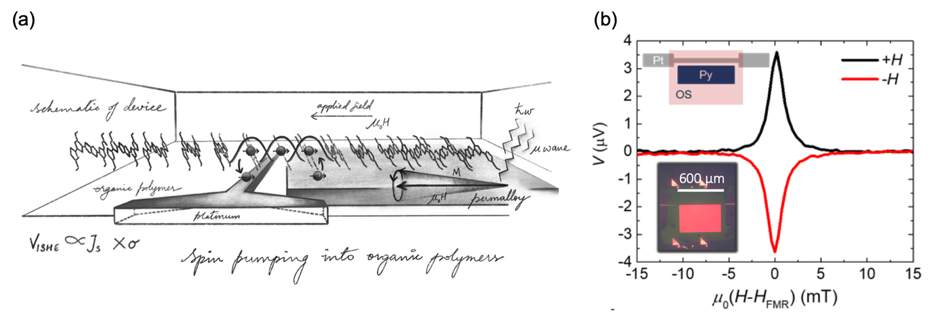The main promise of using organic semiconductors in spintronics lies in the long spin lifetimes that can be achieved in semiconductors composed of mainly carbon and hydrogen. A spin’s orientation and coherence often survive for several microseconds in molecular or polymer semiconductors, which is a time period over a thousand times longer than those of many inorganic metals. This provides more time to manipulate a spin and potentially allows it to travel farther. Long spin lifetimes are a consequence of the light-element composition of these mainly carbon-based materials: there is little perturbation from nuclear spins because the abundant carbon-12 has zero nuclear spin. On top of that, the radial electric fields of the nuclei are small, which results in a weak spin-orbit interaction, which turns out to be both a blessing and a curse. It is highly desirable for spin-transmission layers; however, most spintronics devices (such as MRAM) require the ability to create spin polarisations from electric currents or to convert spin currents to electric voltages, and these conversions require strong spin-orbit coupling. Therefore, it would be useful to be able to tune the strength of spin-orbit coupling.
In 2014, we were awarded a six-year Synergy project by the European Research Council (ERC) to investigate the fundamental spin physics of these organic systems and to explore their use in spintronic devices. The project involves a collaboration of the Cavendish Organic Semiconductor Group with the Hitachi Cambridge Laboratory (Jörg Wunderlich – spintronic devices), the University of Mainz (Jairo Sinova – theory) and Imperial College (Iain McCulloch – chemistry). The capital equipment budget of the project enabled us to install a highly sensitive electron spin resonance (ESR) spectrometer in the Cavendish.
We first aimed to understand how much spin-orbit coupling can be tuned in molecular materials by chemical design. For this we trapped spins on isolated molecules, dispersing them in a solution with sufficient distances to minimise interactions between one another, and studied their ESR response. Previously, we had assumed that the incorporation of heavier elements such as sulphur or selenium into a molecule was the key to increasing spin-orbit coupling; however, we found that changes to the molecular geometry could be just as effective. In fact, when introducing a curve in the backbone of a well-known molecule, we observed that the resulting shifts of the charge distribution would drastically reduce spin-orbit coupling and increase spin lifetimes from just above 1 µs to 100 µs. On the other hand, when aiming to increase spin-orbit coupling, we needed to be strategic about placing heavier elements at positions where their interactions with the spin would be maximised.
Figure 1: (a) Field-induced ESR spectra as a function of gate voltage in a high-mobility, conjugated-polymer transistor architecture; (b) temperature dependence of the spin relaxation time T1 and T2; (c) schematic diagram of different magnetic field environments encountered when charges hop from site to site.
Next, we investigated how structural changes affect spins moving through a stack of molecules in the solid state. At low and intermediate temperatures, we observed that spin lifetimes were closely linked to the mobility of charge carriers: the motion of charges through an environment of nuclear spins and changing spin-orbit couplings were randomising the direction of the spin (Figure 1). However, when approaching room temperature, charge motion and spin relaxation seemed decoupled. The onset and magnitude of this effect could only be explained by vibrations of the polymer chain causing local fluctuations of charge density. Spin-orbit coupling was linking those fluctuations to the spins and eventually causing them to flip. These results have practical implications for the design of polymers: by suppressing the correct vibrational modes, one can potentially design high-mobility polymers with both strong spin-orbit interactions and long spin lifetimes.
Figure 2: (a) Schematic showing the generation, propagation and detection of a spin current within an organic semiconductor film using a lateral spin pumping architecture; (b) Measured voltage in the Pt spin detector in the vicinity of the ferromagnetic resonance. The bottom inset shows a photograph of an actual device.
Armed with this fundamental understanding of spin relaxation mechanisms, we also investigated spin transport in device structures. One such structure (Figure 2) is based on spin-current injection from a ferromagnetic electrode by a process called spin pumping, which involves microwave excitation of ferromagnetic resonance precession of the magnetisation of the ferromagnet. The injected spin current diffuses laterally through an organic semiconductor film and is detected by a platinum electrode with strong spin-orbit coupling, wherein the spin current is converted to a measurable electrical voltage. The magnitude of this voltage decays exponentially with distance from the platinum detector, which allows the determination of the spin diffusion length. We have obtained evidence for long spin-diffusion lengths of micrometres in certain organic semiconductors. Further measurements are currently underway to validate unambiguously these surprising findings.
Our ERC project is entering its final phase and we are currently working on a number of related research directions, including achieving efficient spin-charge conversions as well as realising molecular spin qubits in our materials. Whether organic semiconductors will finally prove their usefulness for spintronic applications remains to be seen, but the knowledge gained through fundamental research is already providing new insight into the field of spin physics. The microscopic understanding of the fascinating and unique interplay between molecular structure, charge and spin dynamics that we have achieved has wide-ranging implications for the physical phenomena that can be observed in organic systems.
References
- Ando, K, et al. Solution-processed organic spin–charge converter. Nature Materials 12, 622 (2013).
- Sinova, J, et al. Spin hall effects. Reviews of Modern Physics 87, 1213 (2015).
- Schott, S, et al. Tuning the effective spin-orbit coupling in molecular semiconductors. Nature Communications 8, 15200 (2017).
- Schott, S., et al. Polaron spin dynamics in high-mobility polymeric semiconductors. Nature Physics 15, 814-822 (2019).
- . Long spin diffusion lengths in doped conjugated polymers due to enhanced exchange coupling. Nature Electronics 2, 98-107 (2019).
In collaboration with:








